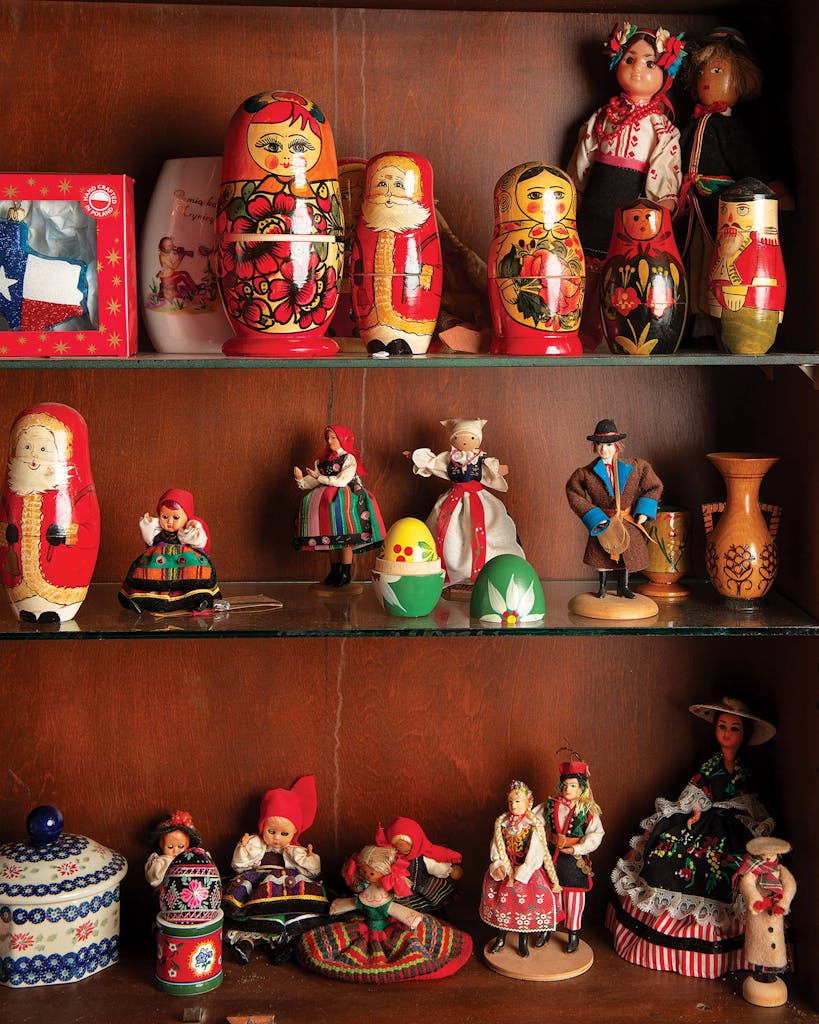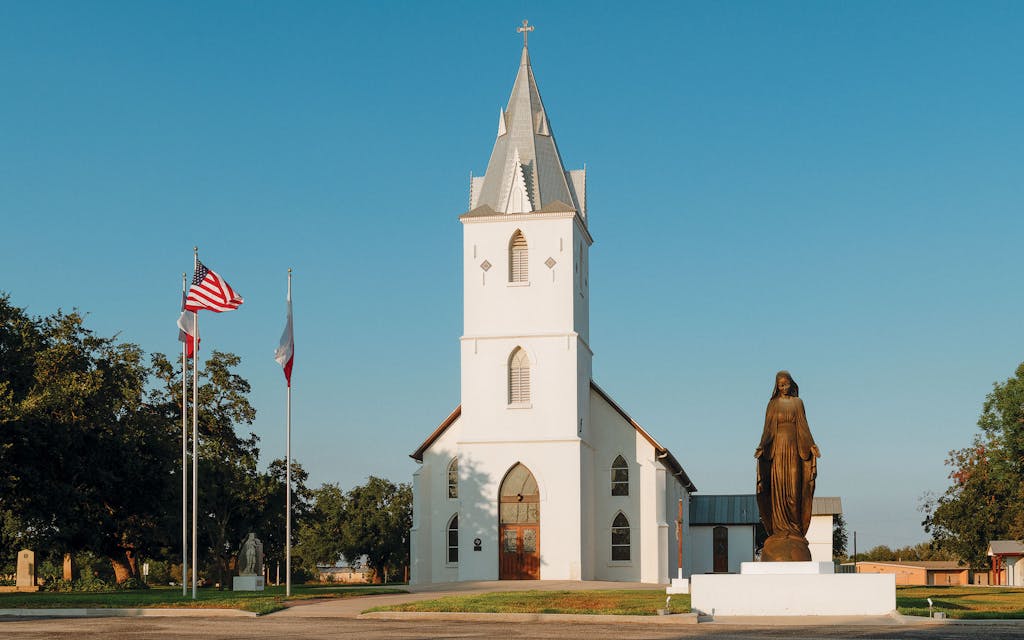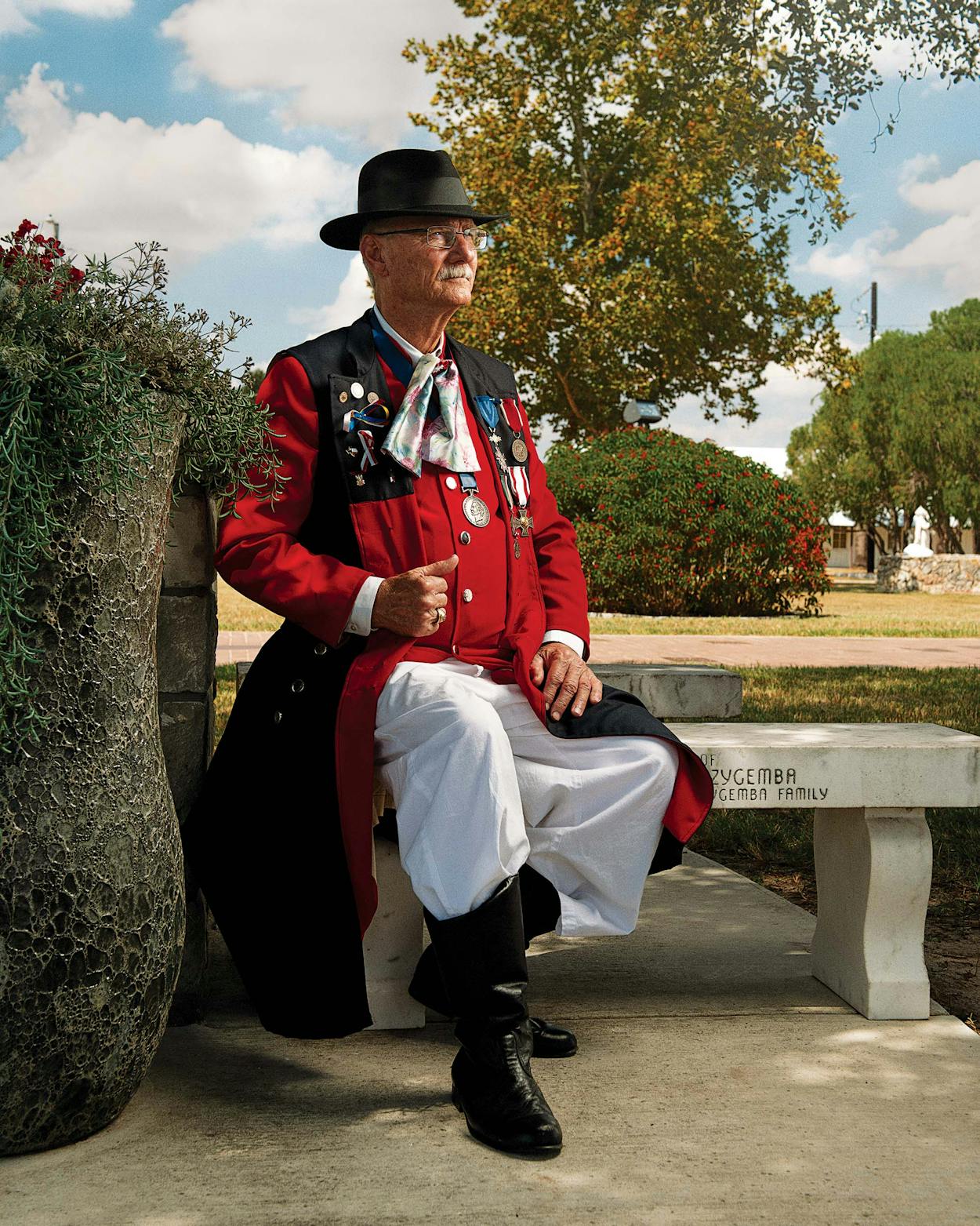The markers of Central Texas’s Czech and German history are well-known—we’re quick to boast of our Oktoberfests, our biergartens, our kolache bakeries. The paths blazed by Central European immigrants two centuries ago are easily traced across the map today: Weimar, Praha, Fredericksburg.
By contrast, our Polish cultural touchstones are less renowned. Yet the routes that make up Texas Polonia are plainly visible, unfurling in succession as you head south from Seguin on Texas Highway 123: Kosciusko, Pawelekville, Cestohowa. The pilgrimage terminates at the site of the oldest permanent Polish settlement in the United States: Panna Maria or, in English, “Virgin Mary.” There was meant to be a marker that would alert tourists to the highway’s turnoff for the town—a towering mother of Christ with a snake coiled at her feet. It’s an appropriate symbol for an area famously ridden with rattlers, but her insurers worried that travelers would stop to take photos, a perilous act on a relatively busy road.
Instead, this formidable figure keeps watch over the town’s main square. A handful of buildings comprise the rest of the immediate panorama: a white church and steeple, a general store cum post office, and two former schoolhouses among them. Farms and gas flares line the middle distance. Three flags—Old Glory, the Lone Star flag, and Poland’s red-and-white banner—announce the town’s allegiances.
Panna Maria’s most imposing feature, though, is an outsized edifice one might mistake for a county courthouse. Opened in 2021, the Polish Heritage Center was founded by Bishop John Yanta, a native of the area and the former head of Amarillo’s Catholic diocese, to preserve the history of his ancestral home.
The 16,500-square-foot center didn’t exist the last time Katarzyna Klessa, a professor of linguistics at Poland’s Adam Mickiewicz University, was here, in 2019. Her first foray to this town of roughly forty, about an hour southeast of San Antonio, was born of curiosity. Panna Maria is known among linguists for ostensibly being the last place where Texas Silesian, an endangered Polish dialect, is spoken. The 46-year-old Klessa was then a visiting scholar at the University of Texas at Austin, specializing in minor languages. Under the auspices of the European Union–funded COLING project, she and her teammates were contributing to the documentation and revitalization of such idioms as Calabrian Greek and Latgalian, spoken in Latvia. The prospect of studying a withering branch of her native linguistic tree naturally piqued Klessa’s interest. “When you’re interested in dialects and Polonia, you just know [about Panna Maria],” she says.
On a recent fall day, the slight, blond, bespectacled Klessa met me for her second trip to town, accompanied by two colleagues from Poland. This time she brought reinforcements in pursuit of a mystery: on that first visit, she’d met almost exclusively English speakers. “Then, after some time, they admitted that when you speak Polish, they can follow along,” she says. “They can catch some phrases.” She conducted one interview with a descendant of the early settlers, who had emigrated in the nineteenth century from the Upper Silesia region of Poland, but notes that her interlocutor didn’t “really like being approached as Silesian. He said, ‘Well, we are first of all Poles.’ ” Still, she hasn’t given up; the area is rural and the homes dispersed, which means there might be language keepers out there, unacknowledged even by their neighbors.
Which prompts the question: What happens if a language dies and nobody cares?


The omission of the Poles from Texas’s historical narrative makes some sense when considered in the context of the nineteenth century. What we now think of as Poland was at that time an amorphous entity carved up between the feuding empires of Austria, Russia, and Prussia. Those empires also encompassed much of what we know as Germany and the Czech Republic, and many of the aspects of Central Texas that we think of as German or Czech might just as reasonably be considered Polish. Our unofficial state pastry originates in Bohemia, in the Czech Republic, but just to the northeast of that region a similar delicacy is known in Polish as a kołaczki. Tejano music might have borrowed the accordion from German settlers, but there’s a reason its chief rhythmic style is called a polka (Czech for “Polish woman”). For years, a movement has been underway to gain recognition for Polish contributions to Texas culture, and Panna Maria is arguably its headquarters.
A brief history of the town begins in the sliver of land known as Upper Silesia, which in the mid-1800s belonged to the Kingdom of Prussia. Facing ethnic and religious discrimination, drought, and conscription into the Prussian army, a group of about 150 Silesians sailed to the port of Indianola, about halfway between Galveston and Corpus Christi. From there they trekked north to an inhospitable plot of land that had been procured for them by the Silesian priest Leopold Moczygemba. They arrived at their new home on Christmas Eve in 1854. Moczygemba held mass under an oak tree, and on that night, legend has it, the first Polish Texan was born. Today the priest is buried under that tree, which stretches its ancient arms over the square.
Panna Maria, at a Glance
Population: Less than forty
County: Karnes
Historical note: Had generally Unionist sympathies during the Civil War, with some settlers killed by lawless cowboys
Claim to fame: Reportedly the nation’s oldest permanent Polish settlement
The next half century provided no shortage of cruel ironies. The settlers were subject to conscription into the Confederate army. Xenophobia was fierce, and the town and church were raided on several occasions in the 1860s by cowboys on horseback. But the settlers persevered, maintaining a bastion of their traditions in isolation for the next hundred-odd years.
Among the remaining cultural touchstones is Texas Silesian. To draw an imperfect parallel, Silesia is to Poland what Catalonia is to Spain or Scotland is to the UK. The regional tongue is different enough from the national language, grammatically and culturally, to have inspired a movement. In recent years, Silesians have shown a renewed interest in teaching Silesian in regional schools, and there has been a push for residents of Silesia to identify themselves as Silesian on the Polish census. There could, someday, be a secession referendum. (To make another imperfect comparison: Silesia is to Poland as Texas is to the United States.) In Karnes County, home to Panna Maria, a variant of Silesian splintered off with the early immigrants, leaving residents to speak a unique dialect that included vocabulary invented for the coastal plain. The settlers hadn’t had much use back home for words like szczyrkowa (“rattlesnake”) and piczesy (“peaches”).
But we’re living through a golden age of language loss. Texasdeutsch, the German dialect long preserved in the Hill Country, is now understood by a mere five thousand speakers; it’s expected to go extinct by 2035. Just across our western border, New Mexican Spanish appears to be on its way out. Even Texan regional English is losing its distinctiveness: How many Yankees have you heard borrowing “y’all” and “bless your heart”? How many young Texans have begun to lose their twang?
It’s no coincidence that this flattening of American speech is picking up speed now, especially in Texas. For a long while, the state provided something of a perfect cradle for language preservation. Many immigrant communities were isolated, left to communicate among themselves. But in 1918 new state laws mandated English instruction in public schools. Then came World War II, which flung residents into urban centers for industrial work, where they encountered different modes of speech. Enter technology—first radio and broadcast television, then social media, now artificial intelligence—and you’re left with a line of linguistic transmission that ends, at best, with the baby boomers.
Klessa and her colleagues are here in hopes that they might document and help preserve Texas Silesian. After all, in their native Poland, the political stakes of keeping Silesian alive are high. In Texas, though, it feels as if the stakes couldn’t be lower. “We can only help if the community wants it,” Klessa says. “It’s not for us to tell them what to do.”


Klessa and her crew are excited to start their day at the shiny new heritage center, which is staffed mostly by Texans from outside Panna Maria. It presents a refined narrative of Polish history in the state, simplified for the average tourist. A 26-minute film recounts the settlers’ journey; elsewhere, nearly two centuries of Polish history are briefly covered, from the November Uprising of the early 1830s to Lech Wałęsa’s 1980s Solidarity movement. It’s no surprise the Catholic Church features prominently in a museum founded by a clergyman: artworks depict Saint Hedwig and Our Lady of Częstochowa, patrons of Silesia and Poland respectively, and photos chronicle the Panna Marians’ 1987 audience with John Paul II, the first Polish Catholic pope, on a visit to San Antonio that Bishop Yanta helped coordinate.
Where Texas Silesian is concerned, a single display panel offers some nuance on “Distinctive Dialects of Polish.” The linguists psst me over to take a look. It describes “a blend of local usage, built upon a Polish framework” that “is augmented by elements of Czech and German,” but it never calls the language by its name. Posters used for instruction at the first local school in the 1920s are on display, but they’re in standard Polish; a plaque notes that the teaching nuns “could not always accommodate” parents’ preference that their children be taught in Silesian.
After lunch, Klessa leads our group across the square for a visit to the Panna Maria Historical Society. Founded in 1966 to “ensure historical preservation and education,” the organization, staffed entirely by townsfolk, is responsible for the upkeep of most of Panna Maria’s landmarks. A few volunteers sit around a table in the middle of a gift shop; “Jak Się Masz, Y’all” koozies and souvenir Bolesławiec ceramics are available for purchase. The society is not to be confused with the heritage center: though the locals are grateful for Yanta’s efforts—Joyce Rives, who gives tours for the historical society, serves as a “community champion” on the heritage center’s board—it’s clear there’s still a touch of competition with the new kid on the block.

Rives, who is seventy, grew up nearby and, in Panna Maria tradition, still tends the land that’s been in her family since the original settlement. She was married in the church. Her paternal line’s surname, Pawelek, inspired the name of the town of Pawelekville, eight miles up the highway.
It’s worth noting that the gift shop koozies don’t read “Jak Się Mosz, Y’all,” as the Silesians would spell it. To hear Rives tell it, the erosion of Texas Silesian has been underway for decades—and she’s unbothered by it. “My parents didn’t use the word ‘Silesian,’ ” she says. “They said ‘Polish.’ We were Polish.” Her Polish does have some peculiarities—the linguists chuckle when she uses a word for snow that in standard Polish signifies something more like sleet, indicating that perhaps the early settlers jettisoned a word of little use in Central Texas winters—and she didn’t use it much until she was an adult. Still, she’s proud to dust it off for her visitors from the homeland.
Rives leads us to the historical society’s own museum, housed in one of the old school buildings. The space, in contrast and complement to the heritage center, is full of intimate possessions—artworks, tools, garments once belonging to the Silesian settlers—that hold sentimental value for their possessors’ descendants. Rives’s children, though, are grown, and they’ve gone to the cities. Her land will stay in the family, but with no one in the lineage to farm it, she expects it will be leased when her time comes.
She’s not alone in her anxieties about who will take up the torch. “We have to involve our youth,” says Jim Mazurkiewicz, the 68-year-old president of the Polish American Council of Texas. He’s concerned that too many old-timers are failing to hand over the reins of maintaining the historical record to a new generation—even if he’s not sure that new generation is interested.
Mazurkiewicz’s family arrived in Galveston in the late nineteenth century, with the second major wave of Prussian Poles, many of whom were brought to Texas as indentured servants after the Civil War to labor in cotton fields. These immigrants came from Greater Poland and established Catholic parishes along the Brazos River from New Waverly to Chappell Hill, about three hours northwest of the Silesian settlements. They too developed a Texan subdialect of their regional Polish, and since his father died, in 2022, Mazurkiewicz, who still lives in the Brazos Valley, thinks he and his mother are probably the last living speakers.

That status doesn’t bother him too much. Mazurkiewicz believes that a modern, thriving Texas Polonia will likely come at the expense of dialectical variants. In fact, he suggests, an emphasis on regional differences such as those between the Brazos Valley and Karnes County branches may be counterproductive. “If Polonia in Texas is to survive,” he says, “we must work together as one Polonia.” He envisions a future for both groups marked by celebration of their shared cultural heritage rather than one fixated on linguistic distinctions or riven by the narcissism of small differences. “Languages evolve,” he says. “We don’t speak the way Ben Franklin did. Polish is evolving too.”
As we wander through the schoolhouse, I ask Klessa what she thinks is lost when a language dies. Some scholars believe that language is inextricable from cognition, that with a specific tongue dies a mode of thought. Others identify each language death as an act of colonial violence. Klessa’s position is more oblique. “People need to know where they’re from,” she replies.
That doesn’t seem to be at issue here—in every corner of Texas Polonia, the heirs to this history seem committed to honoring it. Perhaps it’s not for us to tell them how to do so.

A short drive northwest of the square, the researchers and I end our day in the silence of the Panna Maria cemetery. For a second time, Klessa has failed to find any fluent speakers of Texas Silesian. One of her colleagues, Tomasz Wicherkiewicz, shoots off in one direction in what appears to be a fit of mad delight. She explains, “He’s looking for a marker in the dialect. I took a photo of it the last time I was here.”
Oblivious to the rattlesnakes that may be hiding among the headstones, he checks them all, one by one. Many of the more recent markers are in English, but virtually all the rest are engraved with standard Polish. He waves a hand to us whenever he encounters something interesting—a name of significance, a stone in Czech. But the Silesian marker proves as elusive as Silesian speakers. “Are you sure it was here?” he asks, exasperated, as he arcs back toward us.
Klessa thought so but acknowledges she must have been wrong. The headstone she found must be in some other patch of Texas Polonia, she decides. In this graveyard, as elsewhere, if Texas Silesian lives on, it may not be found, even by those who are looking.
This article originally appeared in the December 2023 issue of Texas Monthly. Subscribe today.









